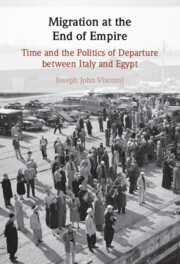Book contents
- Migration at the End of Empire
- Migration at the End of Empire
- Copyright page
- Contents
- Figures
- Tables
- Acknowledgements
- Introduction
- 1 Extraterritoriality and Migrant Diplomacy in Egypt, 1861–1937
- 2 Isolating Time
- 3 Twice without a King
- 4 Becoming Refugees, 1954–1960s
- 5 ‘Leave Us Our Memories!’ Nostalgia, Community, and the Politics of Departure
- Epilogue
- Bibliography
- Index
4 - Becoming Refugees, 1954–1960s
Published online by Cambridge University Press: 30 May 2024
- Migration at the End of Empire
- Migration at the End of Empire
- Copyright page
- Contents
- Figures
- Tables
- Acknowledgements
- Introduction
- 1 Extraterritoriality and Migrant Diplomacy in Egypt, 1861–1937
- 2 Isolating Time
- 3 Twice without a King
- 4 Becoming Refugees, 1954–1960s
- 5 ‘Leave Us Our Memories!’ Nostalgia, Community, and the Politics of Departure
- Epilogue
- Bibliography
- Index
Summary
This chapter illustrates how the categories ‘migrant’, ‘repatriate’, and ‘refugee’ acquired meaning between diplomatic relations and physical displacement. It argues that departure and arrival reified the networks on which the Italian community had been founded in Egypt, as well as the categories of political membership that defined it. Between 1952 and 1956, the Italian government avoided repatriation out of fear that the displaced population would disrupt the postwar economy. The absence of state policy aimed to forestall the creation of a political community of ‘refugees’ or ‘repatriates’. State actors viewed intergovernmental institutions, instead, as opportunities to manage displaced Italians. When the pace of departures quickened after 1953, the Italian government housed ‘repatriates’ in temporary refugee camps and converted Emigration Centres. Seeking to locate themselves in this Cold War Mediterranean, Italians from Egypt institutionalised their associations in and around the camps and holding centres. Pressure from these groups culminated in the extension of refugee status to Italians from Egypt and the consolidation of a political community.
- Type
- Chapter
- Information
- Migration at the End of EmpireTime and the Politics of Departure Between Italy and Egypt, pp. 176 - 222Publisher: Cambridge University PressPrint publication year: 2024

